David's Astronomy Pages
Images - Session 1318 (2025-04-30)
Images
(S1317)
Images
Main
Home
Page
Images
(S1319)
David's Astronomy Pages
|
Images (S1317) |
Images Main |
Home Page |
Images (S1319) |
Objects Session Notes
29P/Schwassmann-Wachmann - Comet AT 2024accj - Type AGN Transient AT 2025fma - Type CV? Transient (non-detection) AT 2025img - CV Type Transient M31 - Spiral Galaxy with Nova M31 2025-04c? NGC 2407 - Elliptical Galaxy with Type Ia Supernova 2025gmc - UGC 5695 w/SN2025cfc & VV 410 w/SN2025hjz attempts failed (due to cloud) Realtime Pictures from Current/Latest Session >> Variable Stars (photometric monitoring) - T CrB, RZ LMi, BL Lac Nearby Stars (astrometric monitoring) - Barnards Star, 61 Cyg, Groombridge 34
- Attemped all-night session (4.4 hr) - 12" LX200 + ST-10XME for imaging - TS 80mm APO + ZWO ASI178MC for guiding & imaging - Ambient Temperature: 8.5°C (min) - CCD Temperature: -10°/-15°C - Notes from 2025-04-30 >> -
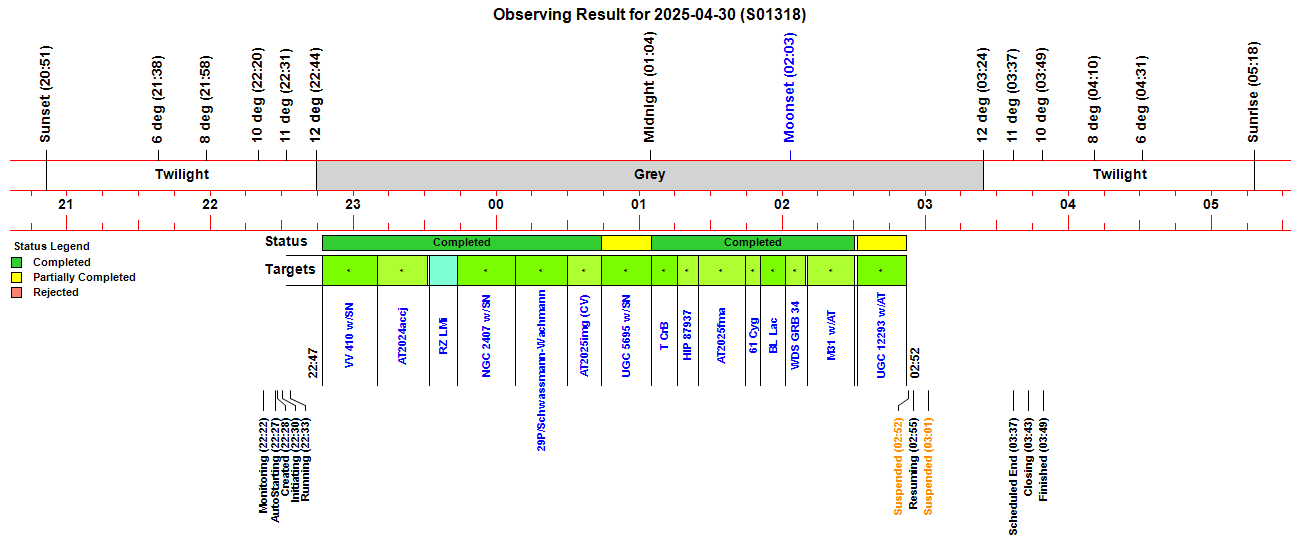 |
Back to Top
| 29P/Schwassmann-Wachmann - 2025-04-30 (passing through Leo) Sun Distance 6.27 AU Earth Distance 5.98 AU (895.0 million km) Poor quality image (uneven sky background) |
29P/Schwassmann-Wachmann - 2025-04-30 Detail Autoguided on offset star using PHD2 with Lock Shift set at the comet's rate of motion (Ra 3.68 arcsec/hr, Dec -1.44 arcsec/hr) |
|
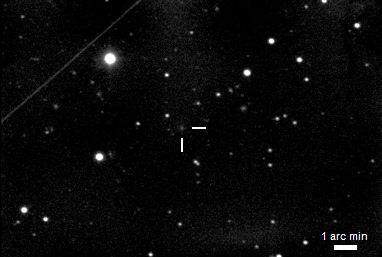 |
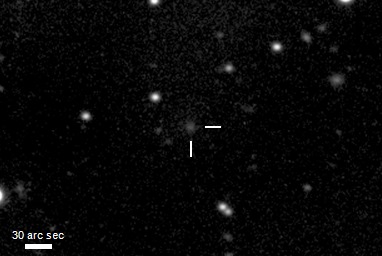 |
|
| Annotated CCD Image (50% size, square root scale) 8 x 90s exposure (average combine), 3x3 binning, Clear Filter 2025-04-30 23:21 UT (#1318037-44) 12" LX200R (at f/10.4) + ST-10XME Auto-guided using TS 80mm APO, ZWO ASI178MC & PHD2 |
Annotated CCD Image (125% size, square root scale, cropped) Image details as left |
|
| Images of 29P/Schwassmann-Wachmann on Comets 2023 Page >> | ||
| Images of 29P/Schwassmann-Wachmann on Comets 2024 Page >> | ||
| Images of 29P/Schwassmann-Wachmann on Comets 2025 Page >> |
Back to Top
|
AT 2024accj (Leo) Alias: In WISEA J093139.04+320400.1 AT 2024accj (Type: AGN) discovered 2024-11-21.656 UT by Gaia Alias: Gaia24dkm Alerting Magnitude 16.86 (G-Gaia Filter) vs Historic Magnitude 17.73 +/- 0.29 SD Long-term brightening in known Seyfert 1 galaxy Object has brightened from mag 18.5 in 2024-2015 to mag 16.9 in 2024 ( TNS 2024accj | Gaia24dkm ) |
|
AT 2024accj - 2025-04-30 (T+160.3d) Image below (2025-04-30.935) was taken 160.3 days after discovery of 2024accj Position of earlier transient (faint) is shown by white cross-hairs Measured Magnitude +16.25 (Clear Filter) Poor qiuality image (CCD interference / single frame) |
|
|
|
Annotated CCD Image (100% size, linear scale, cropped) 180s exposure (single frame), 3x3 binning, Clear Filter 2025-04-30 22:27 UT (#1318021) 12" LX200R (at f/10.4) + ST-10XME Auto-guided using TS 80mm APO, ZWO ASI178MC & PHD2 |
| Images of AT 2024accj on Transients 2024 Page >> |
Back to Top
| AT 2025fma (Cepheus) AT 2025fma (Type: CV?) discovered 2025-03-18.947 UT by XOSS Alias: KATS25F031, TCP J20412701+6308245 Discovery Mag 16.08 (Clear Filter) CV candidate classified by XOSS ( TNS 2025fma ) |
| AT 2025fma - 2025-05-01 (T+43.1d) Image below (2025-05-01.019) was taken 43.1 days after discovery of 2025fma Position of earlier transient (not visible) is shown by white cross-hairs Non-Detection Limiting Magnitude +19.6 (Clear Filter) |
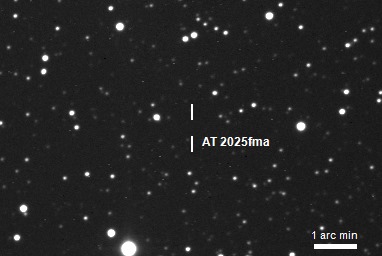 |
| Annotated CCD Image (100% size, square root scale, cropped) 4 x 180s exposure (average combine), 3x3 binning, Clear Filter 2025-05-01 00:35 UT (#1318089-92) 12" LX200R (at f/10.4) + ST-10XME Auto-guided using TS 80mm APO, ZWO ASI178MC & PHD2 |
| AT 2025fma - Earlier Image, 2025-04-11 (T+23.1d) Image below (2025-04-11.057) was taken 23.1 days after discovery of 2025fma Position of earlier transient (faint) is shown by white cross-hairs Measured Magnitude +18.25 (Clear Filter) |
 |
| Annotated CCD Image (100% size, square root scale, cropped) 5 x 180s exposure (average combine), 3x3 binning, Clear Filter 2025-04-11 01:31 UT (#1314128-32) 12" LX200R (at f/10.4) + ST-10XME Auto-guided using TS 80mm APO, ZWO ASI178MC & PHD2 |
| Images of AT 2025fma on Transients 2025 Page >> |
Back to Top
| AT 2025img (Leo) AT 2025img (Type: CV) discovered 2025-04-26.795 UT by MASTER Alias: MASTER OT J105835.04+054705.5 Discovery Mag 16.2 (Other Filter) vs Prior Non-Detection Limiting Magnitude 20.1 Likely progenitor is identified as DR3 3816231274612268544 in the GAIA DR3 database (g-mag of 20.428), implying a brightness increase of approximately 5 magnitudes (Δmag ≈ 5.2). This feature and its spectrum suggest a cataclysmic variable (CV). ( TNS 2025img ) |
| AT 2025img - 2025-04-30 (T+4.2d) Image below (2025-04-30.988) was taken 4.2 days after discovery of 2025img Position of reported transient (faint) is shown by white cross-hairs Measured Magnitude +15.32 (Clear Filter) Poor quality image (uneven background / cloud, single frame) |
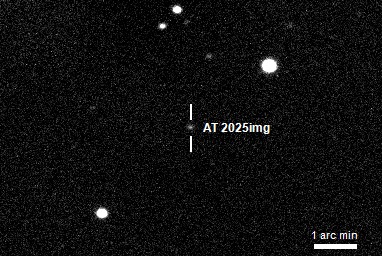 |
| Annotated CCD Image (100% size, linear scale, cropped) 60s exposure (single frame), 3x3 binning, Clear Filter 2025-04-30 23:42 UT (#1318053) 12" LX200R (at f/10.4) + ST-10XME Auto-guided using TS 80mm APO, ZWO ASI178MC & PHD2 |
| Images of AT 2025img on Transients 2025 Page >> |
Back to Top
|
M31 with Nova M31 2025-04c? (Andromeda) |
|
M31 -Spiral Galaxy with Nova M31 2025-04c? - 2025-05-01
(T+14.9d) Cam2 Reference Image Position of Nova M31 2025-04c? (not visible in this exposure) is shown by blue circle Limits of M31 Spiral Galaxy is shown by white ellipse |
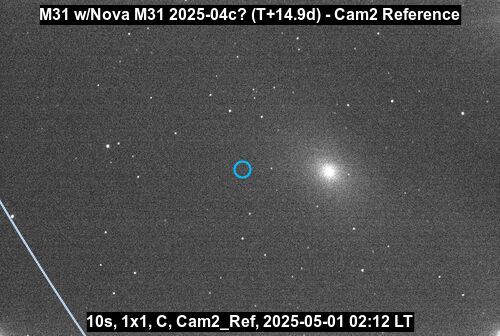 |
| Annotated CMOS Image (16% size) (10s exposure, 1x1 binning) 2025-05-01 02:12 UT TS 80mm APO, ZWO ASI178MC |
|
M31 -Spiral Galaxy with Nova M31 2025-04c? - 2025-05-01
(T+14.9d) Transient position (not readily distinguishable) is shown by white circle |
|
|
|
Annotated CCD Image (70% size, square root scale) 4 x 180s exposure (average combine), 3x3 binning, Clear Filter 2025-05-01 01:22 UT (#1318119-23) 12" LX200R (at f/10.4) + ST-10XME Auto-guided using TS 80mm APO, ZWO ASI178MC & PHD2 |
|
Nova M31 2025-04c? - 2025-05-01 (T+14.9d) Image below (2025-05-01.051) was taken 14.9 days after discovery of Nova M31 2025-04c? Position of reported transient (very faint) is shown by white cross-hairs Estimated Magnitude +17.4 (Clear Filter |
|
|
|
Annotated CCD Image (150% size, square root scale, cropped) 4 x 180s exposure (average combine), 3x3 binning, Clear Filter 2025-05-01 01:22 UT (#1318119-23) 12" LX200R (at f/10.4) + ST-10XME Auto-guided using TS 80mm APO, ZWO ASI178MC & PHD2 |
| Images of Nova M31 2025-04c? (in M31) on Transients 2025 Page >> |
Back to Top
|
NGC 2407 with SN 2025gmc (Gemini) |
|
NGC 2407 - Elliptical Galaxy Other galaxies in same FOV are NGC 2407 (catalog mag 16.5) & PGC 21227 (catalog mag 15.8) |
|
|
|
Annotated CCD Image (50% size, square root scale) 2 x 180s exposure (average combine), 3x3 binning, Clear Filter 2025-04-30 22:55 UT (#1318030-31) 12" LX200R (at f/10.4) + ST-10XME Auto-guided using TS 80mm APO, ZWO ASI178MC & PHD2 |
|
NGC 2407 with SN 2025gmc - 2025-04-30 (T+29.3d) Image below (2025-04-30.953) was taken 29.3 days after discovery of 2025gmc Position of reported supernova (faint) is shown by white cross-hairs Estimated Magnitude +17.4 (Clear Filter) |
|
|
|
Annotated CCD Image (150% size, square root scale, cropped) 2 x 180s exposure (average combine), 3x3 binning, Clear Filter 2025-04-30 22:55 UT (#1318030-31) 12" LX200R (at f/10.4) + ST-10XME Auto-guided using TS 80mm APO, ZWO ASI178MC & PHD2 |
| Images of SN 2025gmc (in NGC 2744) on Supernovae 2025 Page >> |
Back to Top
| UGC 12293 with AT 2025gyi (Pegasus) AT 2025gyi (Type: unk) discovered 2025-04-07.505 UT by ZTF using Palomar 1.2m Oschin Telescope Alias: ZTF25aalvyrp Discovery magnitude 18.36 (r-ZTF Filter) ( TNS 2025gyi) |
| UGC 12293 with AT 2025gyi - 2025-05-01 (T+23.6d) Image below (2025-05-01.067) was taken 23.6 days after discovery of 2025gyi Position of reported transient (very faint) is shown by white cross-hairs Estimated Magnitude +18.5 (Clear Filter) |
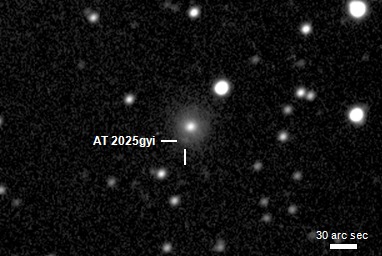 |
| Annotated CCD Image (125% size, square root scale, cropped) 5 x 180s exposure (average combine), 3x3 binning, Clear Filter 2025-05-01 01:44 UT (#1318126-30) 12" LX200R (at f/10.4) + ST-10XME Auto-guided using TS 80mm APO, ZWO ASI178MC & PHD2 |
| Images of AT 2025gyi (in UGC 12293) on Transients 2025 Page >> |
Back to Top
| This Web Page: | Images - Session 1318 (2025-04-30) |
| Last Updated : | 2025-05-22 |
| Site Owner : | David Richards |
| Home Page : | David's Astronomy Web Site |